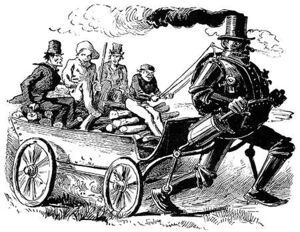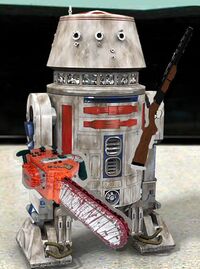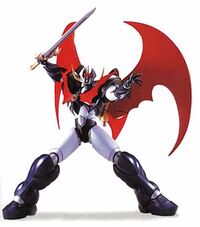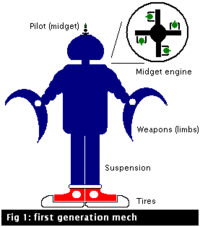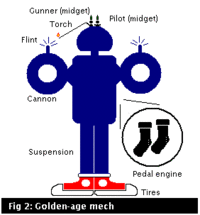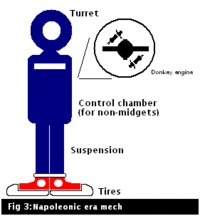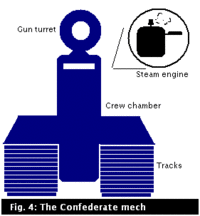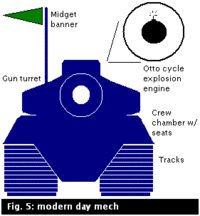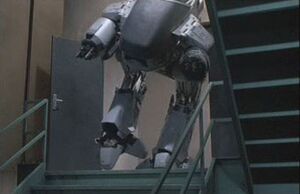Mecha
- You may be looking for Mecca and not even know it!
Mechas (from Italian Inciampata Mecchanica, "incredibly clumsy walking thing"), also known as Mech, Groundy, Stay-off, Run-run-run, Lumber and Pilot-mincer (among others) were ancient war devices used from 16th to the 19th century. Mechas replaced catapults and preceded tanks as the favorite toy of high military officers.
Mecha mechanics[edit]
Mechas consist in three basic components:
- Something;
- Legs sustaining something;
- Something to put the legs on and something to move the something.
See below Mecha Evolution for more details.
Mecha history[edit]
Mechas were first conceived and sketched by Leonardo da Vinci in A.D. 1499 and promptly put to use in Italian battlefields. The "Malledetto Uno" was employed to carry blocks of ice to the officer's bar. In a few days of action, officers realized that the walking thing had much more military potential than just carrying stuff and falling to the ground. It was really capable of instilling fear in troops, and this turned to be an important morale factor: "If you don't obey, you have to drive the mecha!". Aside from disciplinary measures, Italian officers also found a way to use mechas against their enemies, as even an unarmed mecha was capable of dealing massive damage. They sent the mecha to the forefront and just let it do what it did better: fall and crush opponents below. With this tactic, European militia would incorporate mechas to their strategies for the coming centuries, and a wealthy mecha industry flourished in Renaissance Italy.
Mecha Golden Age[edit]
As a way to prevent this dangerous weapon of falling into enemy hands, Italian mecha builders rigged export-type machines with cannons, thus making them completely useless: a mecha would always fall back when the gun recoiled. For mysterious reasons, probably just because they looked cool, armed mechas were incorporated in almost all Western powers' military forces, starting what is now known as The Golden Age of Mechas (1582-1792). In the 16th Century, the Portuguese sold obsolete unarmed models to the Japanese - they called it Gundam ("Seppuku device", a mistranslation from the Japanes "Ma-Jin-Ga" or "Ma, ZING her") and started to develop their own tradition in mechas. Japanese mechas are distinctive in their human-like appearance, resembling samurai armor, generally equipped with blades (which is an odd fact considering that the Portuguese introduced them to gunpowder at the same time). Gundams were used as an alternative to seppuku: a dishonored samurai could opt to drive one instead of direct suicide. Another innovation was incorporated when the Japanese faced the Kaiju invasions: engineers studied the enemy's weapons and successfully fitted their gundams with zip fasteners on their backs.
Mecha Evolution[edit]
First Generation[edit]
From Leonardo's Maledeto to the first armed models, technological limits of the era imposed size limitations to mecha building, rendering them driveable only by midgets. By the same reason, the powering system of this early mechas consisted of a capstan connected by ropes to the arms and legs of the machine. The mecha could move when the handles where pulled by four or more stout dwarves. The introduction of mechas raised brutally the military midget demand and so the salaries paid to them. By 1582, a midget would receive about five times a foot soldier salary. The most basic mecha maneuvers were developed in this era:
- Falling sideways: when the mecha was at the enemy field, midgets just swung from one side to the another until it tipped over;
- Falling forward: the same as above, just changing the swinging angle.
- Stumble: as a way to make the fall quicker, the pilots just kept on walking until the inevitable occurred at some point.
Golden Age Mechas[edit]
As exposed above, Italians found cannon-equipped mechas impractical, but sold them to gullible armies around the world. By the Golden Age of Mechas, military midget earnings where so high that engineers thought a way to reduce the midget crew inside a mecha. They expanded the main chamber to fit four or more regular soldiers that would power the machine with crankshafts or pedals. The most common design of this era was a 20-foot tall machine with two lateral cannons instead of the previous models limbs. An additional midget worked as the gunner, lighting the cannons' flints and, if not jettisoned to the ground, running to the guns in an attempt to reload them. As stated before, recoil was a major issue, firing one cannon would make the machine spin and fall, and firing both simultaneously made it drop backwards. A common way to deal with this problem was employing a land crew to put the mecha standing upright again. By this time, there were two maneuvers employed by mecha pilots:
- Firing forward, dropping backward: using the mecha cannons as cannons, this tactic made famous the midget war cry, in a way to warn troops behind of what was going to happen: "Lumber!!!". This tactic was not favored by generals, who found the next one much more pleasing;
- Firing backward, dropping forward: the mecha would enter the enemy battlefield, as in the older "falling" maneuvers, but then would turn its back to the enemy army and fire in the direction that it had just come. This made the crash much more powerful, but was quite unpopular among allied foot soldiers.
Napoleonic Mechas[edit]
In the 18th century, mechas could be constructed large enough to dispense human power. This way it was possible to build the first donkey-powered mechas, fitted in a horsemill-like scheme. By this time, the massive employment of midgets as mecha pilots had diminished their population almost to extinction so, despite major complains of the officiality, taller pilots started being trained. In order to allow space for a regular pilot, the crew chamber was moved from the machine's 'head' to the 'chest', just above the donkey. The unused space over the mecha allowed the development of the first revolving turrets, with which mechas could aim without having to turn around (making a mecha turn had a 70% possibility of it stumbling on its own feet). As recoil was still a problem, a new maneuver was introduced by Napoleon himself:
- Buried mecha: troops dug a trench large enough to fit the mecha, then covered his legs with earth in order to fix it in position. When questioned if this maneuver was not just turning a mecha into a cannon, Napoleon answered: "How dare you?! Mechas are the last word on military technology! Cannons are just stupid tubes with one end capped. And mechas have midgets!... Hey, what are you laughing at?!".
Civil War Mechas[edit]
Despite Napoleonic maneuvers making the machines less prone to falling at the incorrect moment, burying the mechas wasted lots of precious battling time. The question of abandoning mecha's legs were raised by several military engineers, but never taken seriously, as wheels were considered rather uncool. In American Civil War, the Confederate Army fitted steam engines into their mechas and introduced a definite innovation: the tracks. Tracks were mean-looking enough to overcome the officer's resistance in replacing mecha's legs. This way, it was possible to do what was believed to be impossible: firing a mecha without having it falling. Non-legged mechas proved to be far superior in direct conflict as well: if they crashed against a regular mecha, they would just trample it to the ground and run it over. Had the Confederates not have run out of midgets (Southern generals valued too much the military tradition to accept regular soldiers driving mechas) this could have turned the war in favor of the South,. In this era, two new maneuvers were introduced:
- Trample: the mecha would run over anything in front of it. Sweet!
- Fight: the mecha just fired its weapon and continued battling. Incredible, isn't it?
Modern Day Mechas[edit]
By the time of WWI, there was just one issue left before reaching the definitive design in mecha building. Mechas did not fall anymore, but were still a very big target to ever-evolving artillery. So British engineers decided to turn the mecha body to a horizontal position, this way making them shorter and sturdier. This configuration was very successful and was copied by every army in the world (except the Japanese). But at the same time, this mechas were so different from the original concept that the Royal Army dubbed the new machine as The Tank. In WWII, German forces gave a final homage to the older mecha tradition: they placed a green flag at a pole atop the turret, this way remembering the romantic days of heroic midgets fighting from above and yelling "Lumbeeer!!!".
Mecha Countermeasures[edit]
When facing colonial powers, native resistance developed several guerrilla tactics against mechas:
- Marbles: the very first anti-mecha technique, developed by Italian soldiers as a way of mocking the midgets. Just drop the little balls at the ground and the mecha can't stay upright.
- Stairs: first employed by the Aztecs against Pizarro invasion force. Just climb to an upper position and attack from there. Mechas cannot climb stairways. Also displayed on Robocop series.
- Rope: surprise the enemy with a chord stretched about 2 feet from the ground in front of the mecha's legs. Developed by the Zulu against British Royal Army and displayed on Star Wars series.
- Bamboo cane: with a cane of 10 feet of more, it's easy to drop a mecha to the ground. Foot soldiers can push the upper part of the mecha or just place the cane between its legs. Developed by the Japanese in feudal wars.
- Elephant: used by Indians against British Empire. The animal can bump into the mecha, making it crash, or it can just pluck the pilots out of the mecha with his trunk. Very funny, indeed.
- Kyōshirō Tōdō: used by the Elevens against the Britannian invasion at the Battle of Itsukushima, a.k.a the only battle they won. Critics however, contend that the victory was in fact due to the fact that the Britannian commander was a total Wanker who sent his troops to capture a tiny island that was too insignificant to even have a Highschool or Traffic Lights.
- Cosmic Rust Gun: Sentinel Prime's weapon of choice when all else fails The effects of the weapon is very devastating as it causes instant corrosion and rusting to the target.
Mecha Revivalism[edit]
As with the swords, popular culture and entertainment industry fancies the idea of honor and heroism related to the legged-era mechas. Vintage machines were featured in Star Wars, The Matrix and several anime series, such as Things often confused with Neon Genesis Evangelion. There's no serious plan of any to build an army of walking combat robots...other than those 6 legged BigDogs in Iraq and Afghanistan, or that 13 foot tall Method 2 walking suit in Korea. I mean why bother pouring millions of dollars into developing artificial legs so a tank can go spelunking into caves, climb mount Everest and do ballet across a mine field when you've got a flock of unmanned aerial drones and quad copters that can fly a foot off the ground? How many wars are really going to be fought against subterranean mole people to justify this to actually justify this to the armies budget committee? Before his death at the mechanical maw of Jaws, Osama bin Laden issued a statement that is often cited as a major endorsement regarding mecha revivalism: "Putting down a tank by stretching a wire in its path... Man, this is a terrorist rebel group's dreams come true! I mean, haven't the American devils ever seen The Empire Strikes Back before?"
